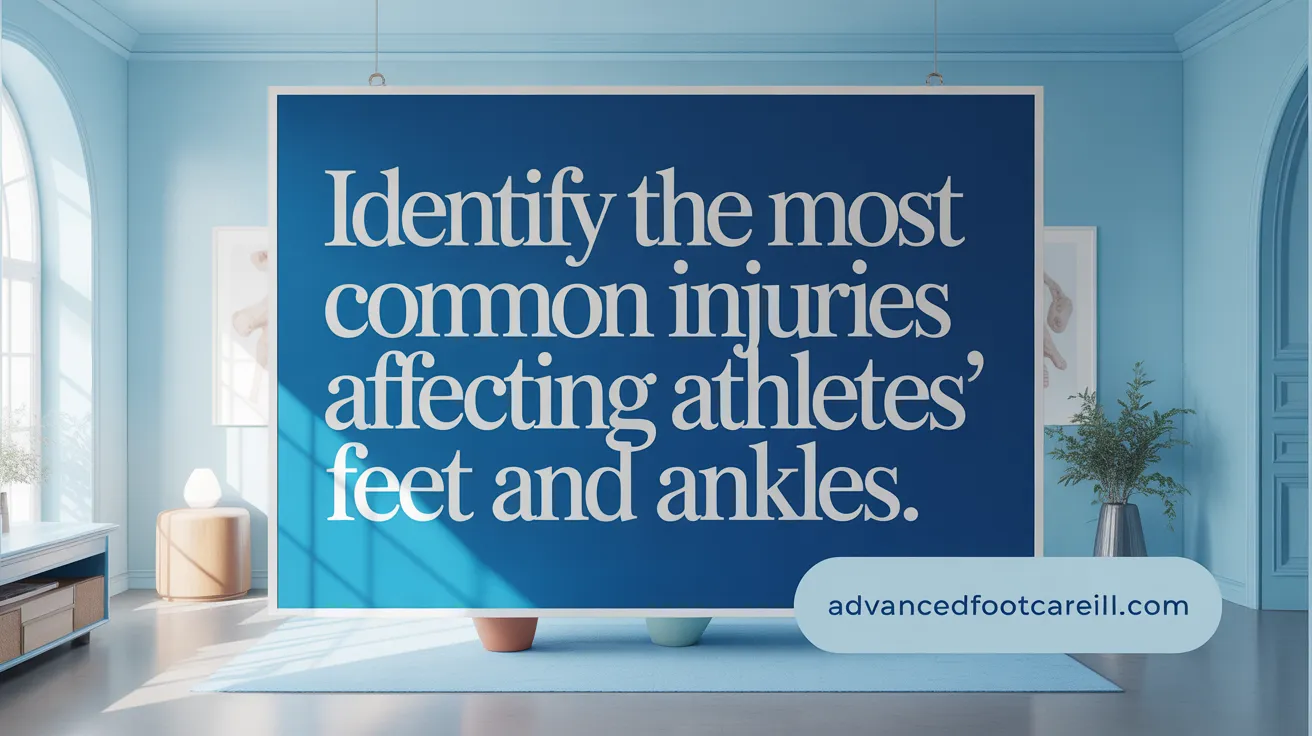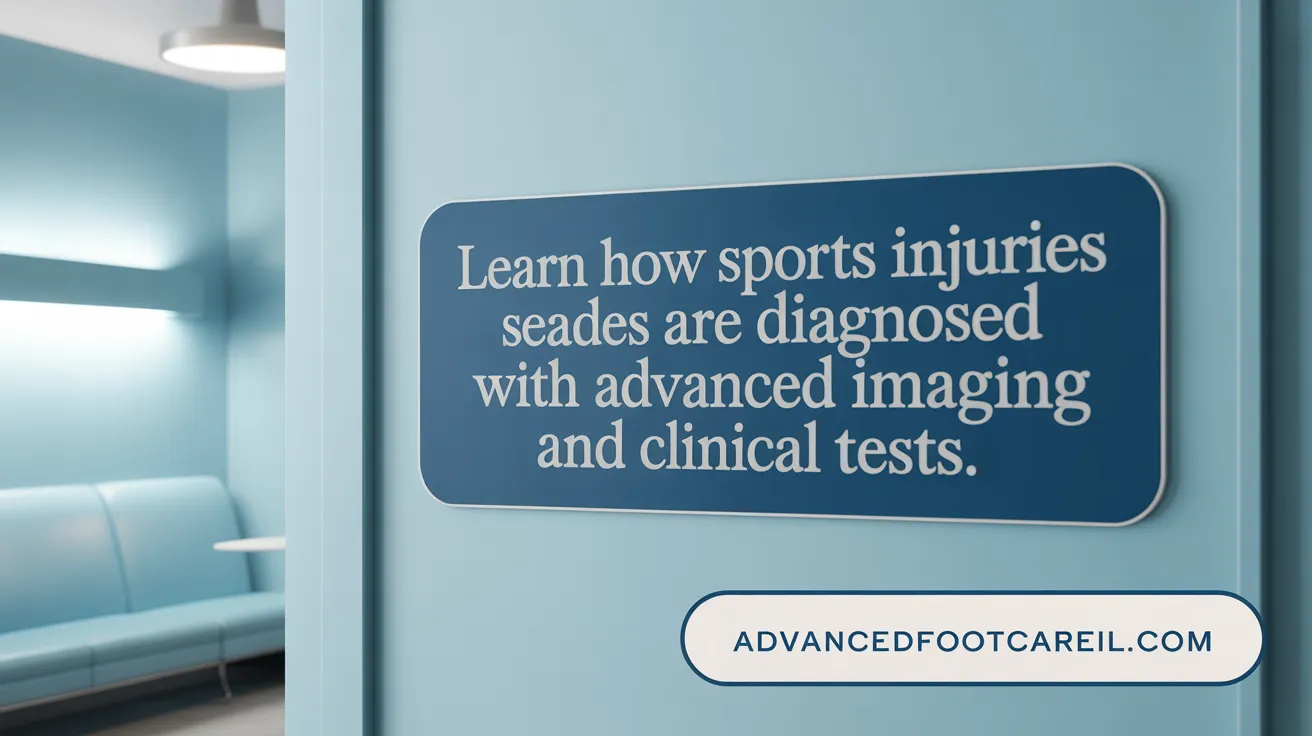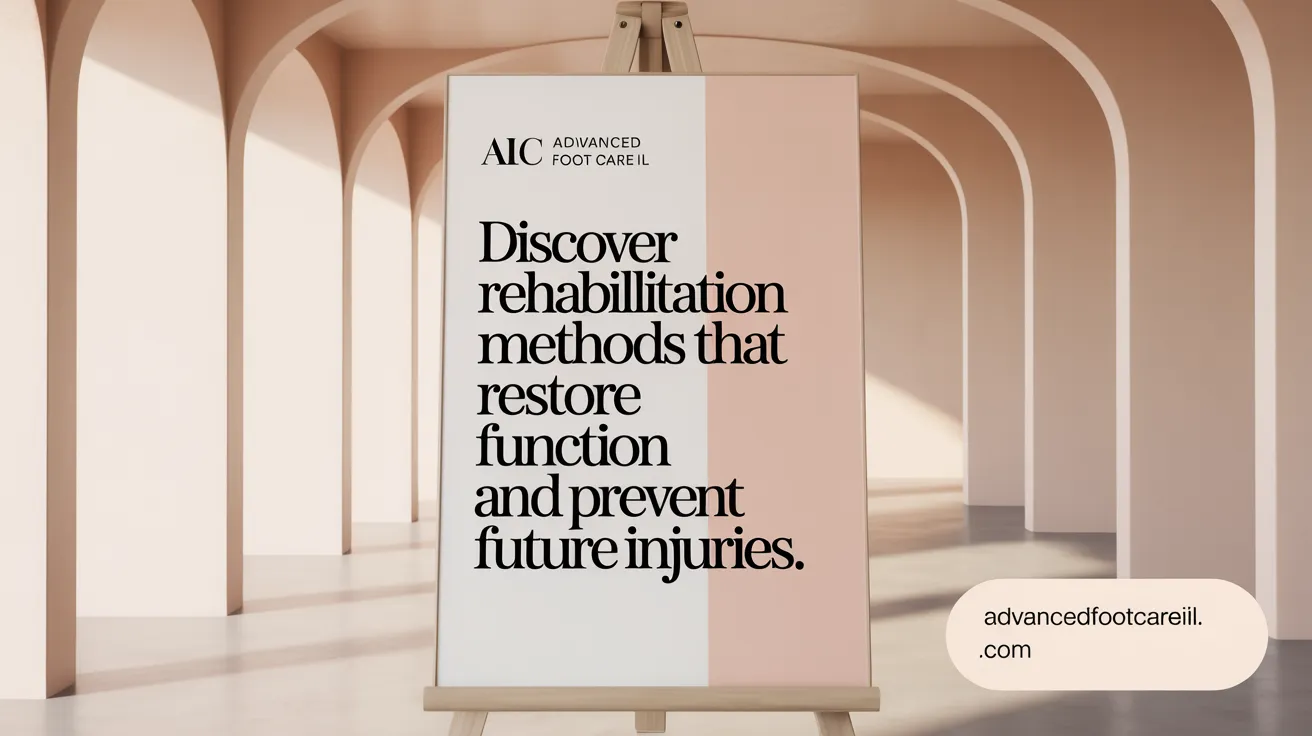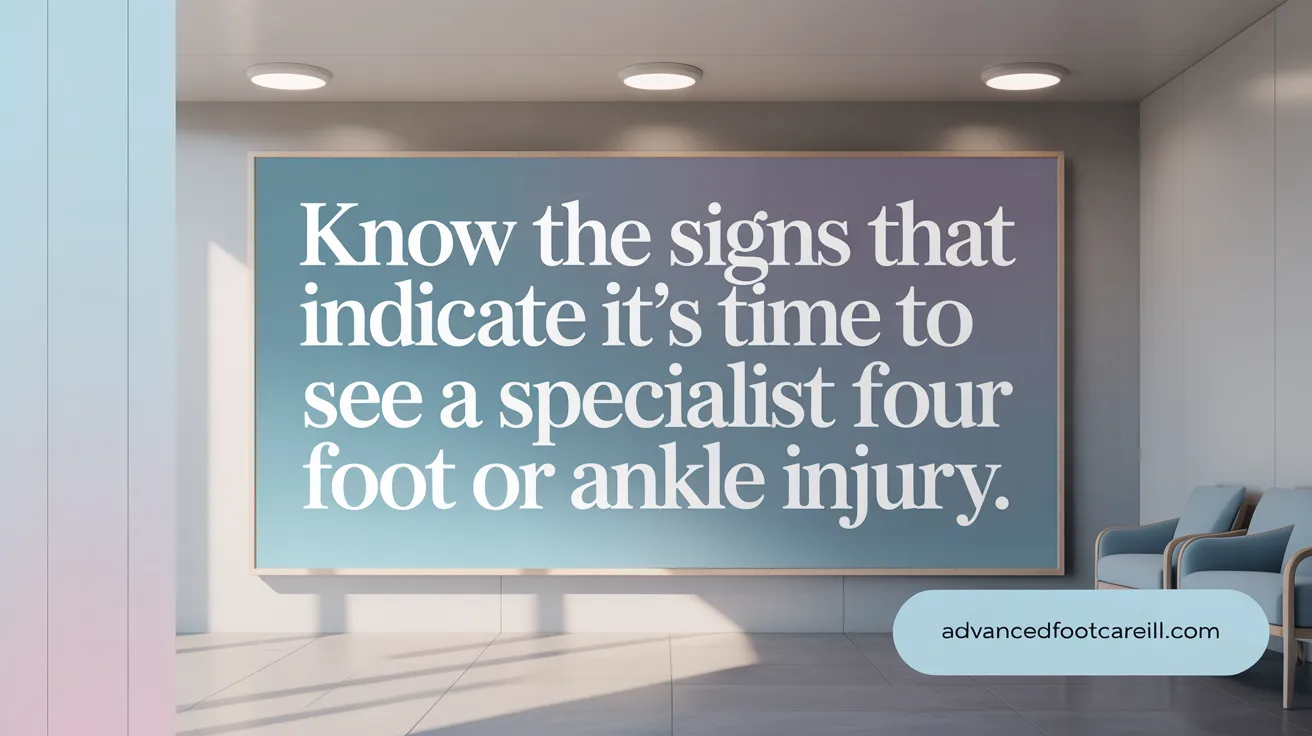Introduction to Sports-Related Foot and Ankle Injuries
Sports-related foot and ankle injuries are among the most common challenges faced by athletes, stemming from the complex anatomy and high demands placed on these structures during physical activity. This article explores the types of injuries athletes frequently encounter, how to recognize them, effective treatment methods, and strategies for prevention and rehabilitation to ensure a safe return to sport.
Common Types of Sports-Related Foot and Ankle Injuries

What are the common sports-related foot and ankle injuries?
Common sports-related foot and ankle injuries include:
- Ankle sprains: Ligament injuries caused by twisting or rolling motions. For more information on ankle sprains in athletes and ankle sprains in sports.
- Plantar fasciitis: Inflammation of the plantar fascia causing heel pain. Learn about plantar fasciitis in runners and plantar fasciitis diagnosis.
- Stress fractures: Small cracks in foot bones like metatarsals and navicular due to repetitive stress. See details on foot stress fractures and stress fractures in sports.
- Achilles tendinitis and ruptures: Inflammation or tears of the Achilles tendon caused by overuse or trauma. Read about Achilles tendinitis causes and Achilles tendon injuries.
- Turf toe: Sprain of the big toe joint from hyperextension. Information on turf toe in athletes and turf toe injury.
- Heel spurs: Calcium deposits on the heel bone from repetitive stress. Learn more about heel spurs and heel pain and heel spurs causes and treatment.
- Neuromas and other nerve injuries: Nerve compressions causing tingling or burning sensations. See Morton’s neuroma diagnosis and treatment.
- Fractures including Jones and Lisfranc injuries: Bone breaks especially in the fifth metatarsal (Jones fracture) and midfoot joints (Lisfranc injury). Explore Jones fractures in athletes and Lisfranc injury diagnosis and treatment.
What are the causes and symptoms of these injuries?
- Ankle Sprains result from sudden twisting or rolling, often during quick sports pivots, leading to ligament overstretching and pain, swelling, especially on the outer ankle. See diagnosis of ankle sprain and ankle sprain rehabilitation exercises.
- Plantar Fasciitis occurs due to overuse, biomechanical imbalances, or poor footwear, characterized by sharp heel pain, especially with the first steps in the morning or after rest. More at plantar fasciitis diagnosis and plantar fasciitis overview.
- Stress Fractures develop from repetitive impact; symptoms include localized tenderness, swelling, and pain that worsens with activity but improves with rest. See stress fractures in athletes and foot stress fractures.
- Achilles Tendinitis and Ruptures arise from overuse, inadequate stretching, or improper footwear, presenting as tendon pain, swelling, and in ruptures, sudden severe pain with difficulty walking. Learn about Achilles tendinitis symptoms and Achilles tendon rupture diagnosis.
- Turf Toe is caused by excessive upward bending of the big toe, commonly on artificial turf surfaces, leading to joint pain, swelling, and limited toe movement. More details can be found in turf toe injury and turf toe in athletes.
- Heel Spurs are calcium deposits caused by repetitive stress, presenting as heel pain exacerbated by weight-bearing. See heel spurs and heel pain and heel spurs causes and prevention.
- Neuromas (pinched nerves) cause tingling, numbness, burning pain—often between the toes due to nerve compression. Learn about Morton Neuroma symptoms and treatment.
- Fractures like Jones and Lisfranc show acute pain, swelling, bruising, and inability to bear weight, often needing imaging for diagnosis and sometimes surgery. See Jones fractures in athletes and Lisfranc injury diagnosis and treatment.
Awareness of these injury types, their causes, and symptoms is vital for early treatment and prevention strategies in athletes and active individuals. For comprehensive guidance, visit resources on sports injuries of the foot and ankle and sports medicine for foot injuries.
Diagnosing Foot and Ankle Injuries in Athletes

How are sports-related foot and ankle injuries diagnosed?
Diagnosis of foot and ankle injuries in athletes begins with a detailed history and thorough physical examination. The assessment focuses on the location and nature of pain, swelling, any visible deformities, and the athlete’s ability to bear weight. Palpation is used to identify tenderness over specific bones, ligaments, and tendons, helping to pinpoint injury sites.
Specific ligament and tendon tests are essential. For example, the anterior drawer test evaluates the anterior talofibular ligament's integrity, critical for detecting lateral ankle sprains. Other special tests assess structures like the calcaneofibular ligament, Achilles tendon, and the big toe joint. These clinical examinations help classify the severity and guide treatment.
Imaging modalities play a complementary role in diagnosis. X-rays are the first step to exclude fractures. The Ottawa Ankle Rule guides clinicians on when an X-ray is necessary, preventing unnecessary radiation exposure. Magnetic resonance imaging (MRI) provides detailed visualization of soft tissues, including ligaments, tendons, cartilage, and bone marrow edema, making it invaluable for diagnosing sprains, ruptures, and osteochondral injuries. Computed tomography (CT) scans offer detailed bone imaging in complex cases. Ultrasound is particularly useful for dynamic assessment of tendons, detecting tears, and evaluating neuromas.
Symptoms warranting urgent medical evaluation include significant deformity, severe or rapidly increasing swelling, inability to bear weight after an injury, open wounds or bleeding, severe pain, and signs of neurovascular compromise such as numbness or tingling. Early and accurate diagnosis ensures appropriate management, reducing the risk of complications such as chronic instability or arthritis.
Treatment Strategies for Foot and Ankle Sports Injuries

What are the standard treatment methods for these injuries?
For mild to moderate foot and ankle sports injuries, the initial care typically revolves around the RICE protocol—Rest, Ice, Compression, and Elevation. This approach helps reduce swelling, control pain, and limit further damage immediately after injury.
Non-steroidal anti-inflammatory drugs (NSAIDs) such as ibuprofen are commonly used to manage pain and inflammation alongside RICE.
Physical therapy and rehabilitation
Physical therapy plays a crucial role in recovery by restoring joint range of motion, rebuilding muscle strength, enhancing neuromuscular coordination, and improving balance. Exercises may include stretching, strengthening (like heel raises), proprioceptive drills (balancing on unstable surfaces), and gait training. These efforts prevent chronic instability and reduce the risk of recurrent injuries.
Non-surgical treatments such as orthotics and NSAIDs
Orthotic devices and specially designed supportive footwear help correct biomechanical problems, redistribute pressure, and stabilize the foot. These non-surgical options are especially useful for conditions like plantar fasciitis, Achilles tendinitis, and stress fractures. NSAIDs complement these by easing discomfort.
Surgical interventions for severe cases
Severe injuries—including complete ligament ruptures, unstable fractures, high-grade ankle sprains, and Achilles tendon ruptures—may require surgery. Procedures such as ligament repair, open reduction and internal fixation (ORIF) for fractures, or Achilles tendon reconstruction aim to restore anatomical alignment and function. Surgery is followed by carefully supervised rehabilitation to regain mobility and strength.
Medications for pain and inflammation
Pain management often utilizes NSAIDs for their anti-inflammatory effect. In some cases, prescription medications may be necessary. Corticosteroid injections can help in chronic inflammatory conditions but are typically used cautiously.
Role of braces and supportive footwear
Use of ankle braces or taping during rehab and when returning to sports provides external support to vulnerable ligaments, enhancing stability and confidence. Proper sport-specific footwear also contributes to injury prevention and recovery by offering adequate cushioning and foot control.
In summary, treatment plans for foot and ankle sports injuries are carefully tailored to the individual, considering injury severity and the athlete's demands. A combination of rest, medication, physical therapy, supportive devices, and when needed, surgery, offers the best path to recovery and return to sport.
Rehabilitation and Recovery for Athletic Foot and Ankle Injuries

How does rehabilitation help athletes recover from foot and ankle injuries?
Rehabilitation following foot and ankle injuries is vital to restoring function and preventing chronic issues. It starts with managing pain and swelling through rest, ice, compression, and elevation. Early phases focus on gentle range of motion exercises to regain flexibility.
Therapeutic exercises gradually advance to strengthening muscles around the ankle and foot. Heel raises, toe pick-ups, and calf stretches improve muscle support and joint mobility. Neuromuscular training involves balance exercises on unstable surfaces, enhancing proprioception and stability.
As recovery progresses, sport-specific and functional activities are introduced to prepare athletes for return to play. Physical therapy modalities such as manual therapy, MLS Laser Therapy, and extracorporeal shockwave therapy (EPAT) support tissue healing and pain reduction.
Prevention of reinjury is key; athletes often use ankle braces or taping during and after rehabilitation (ankle injury prevention). Compliance with rehab protocols is critical for successful outcomes and avoiding recurrent injuries.
Effective rehabilitation addresses:
- Pain and swelling control
- Joint range of motion restoration
- Muscle strength rebuilding
- Balance and neuromuscular coordination
- Sport-specific movement training
- Injury prevention strategies
Through this phased approach, athletes can safely return to sport with improved function and stability.
Preventing Foot and Ankle Injuries in Sports
What measures can athletes take to prevent foot and ankle injuries?
Athletes can reduce the risk of foot and ankle injuries through several proactive strategies. Proper warm-up and cool-down exercises prepare muscles and joints for activity and aid recovery post-exercise. These include light stretching, jogging, or sport-specific movements to increase blood flow and flexibility.
Strengthening and balance exercises are vital. These improve joint stability and proprioception, helping athletes control ankle movements better and avoid sprains. Exercises might involve heel raises, toe pick-ups, balance on one leg, and use of unstable surfaces to challenge neuromuscular control (Exercises for Foot and Ankle Injury Recovery).
Choosing the correct sport-specific footwear is essential. Shoes designed for particular sports provide needed support and cushioning, reducing impact and preventing biomechanical faults. Custom orthotics tailored from biomechanical assessments can further correct foot alignment and support individual needs (Footwear for injury prevention).
Gradual progression in training intensity allows the muscles, bones, and connective tissues time to adapt, significantly reducing the chance of stress fractures and overuse injuries (Preventing sports foot injuries.
Avoiding uneven surfaces, such as rocky trails or slippery fields, decreases the risk of acute twisting injuries like ankle sprains (Preventing Foot and Ankle Injuries. Additionally, good hydration and nutritional practices maintain tissue health and optimize recovery (Sports injuries prevention, treatment, and recovery tips).
Finally, athletes should pay close attention to early warning signs like pain or swelling. Promptly addressing discomfort by resting or modifying activity helps prevent minor issues from developing into debilitating injuries (When to see a podiatrist.
When to Seek Professional Care and Advanced Treatment Options

Signs and Symptoms Requiring Medical Evaluation
Athletes should promptly seek medical attention if foot or ankle pain is severe, accompanied by rapid swelling, deformity, inability to bear weight, or a popping sound at the time of injury. Persistent pain or instability beyond a few days also warrants professional assessment to avoid chronic complications (source, source).
Importance of Early Intervention
Early evaluation and proper diagnosis prevent long-term effects such as joint instability, arthritis-like pain, and tendon or cartilage damage. Timely intervention improves healing and reduces the risk of recurrent injuries (source, source).
Advanced Diagnostic Tests
To accurately diagnose the extent of injury, imaging techniques such as MRI, ultrasound, digital X-rays, and bone scans are utilized. These tests help identify subtle fractures, ligament tears, or soft tissue damage that may not be visible on standard X-rays (source, source, source).
Specialized Treatments
For injuries resistant to conventional therapy, advanced modalities like MLS Laser Therapy and extracorporeal shockwave therapy (EPAT) promote tissue repair and pain relief. Customized orthotics crafted after biomechanical assessments enhance support and injury prevention (source, source).
Surgical Repair Techniques and Innovations
Severe injuries may require surgical repair ranging from minimally invasive ligament reconstruction to complex procedures like total ankle replacement. These innovations aim to restore function, reduce pain, and enable return to activity (source, source).
Multidisciplinary Care Approach
A team of orthopaedic surgeons, podiatrists, physical therapists, and sports medicine specialists collaborate to develop personalized treatment plans. This coordinated care ensures comprehensive management, addressing all aspects from diagnosis and treatment to rehabilitation and injury prevention (source, source).
Conclusion: Ensuring Safe Return to Sport
Foot and ankle injuries in athletes range from minor sprains to complex fractures and tendon ruptures. Accurate recognition, prompt diagnosis, and appropriate treatment are essential to optimize outcomes and reduce the risk of chronic problems. Rehabilitation focusing on strength, balance, and gradual return to activity prevents reinjury, while preventive strategies including proper footwear, conditioning, and awareness decrease the likelihood of injury. Collaboration among athletes, healthcare professionals, and coaches fosters a comprehensive approach to care, facilitating safe and effective return to sport. Emphasizing education and early intervention remains paramount in managing sports-related foot and ankle injuries.
